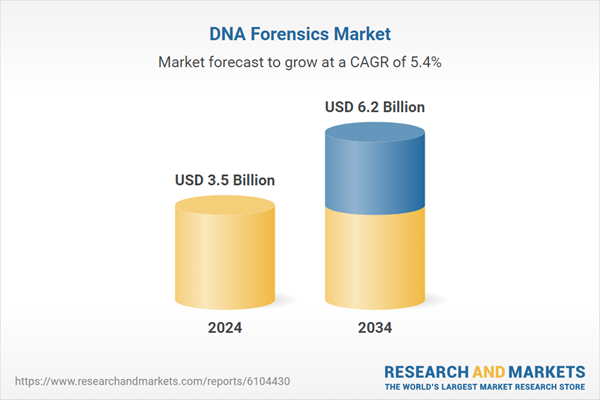Furthermore, the integration of advanced technologies in forensic labs is streamlining the analysis process and helping authorities address complex criminal cases more efficiently. Governments across multiple regions are actively supporting forensic labs with funding and infrastructure upgrades, which is further accelerating the use of DNA forensics in criminal justice systems. Meanwhile, private sector players are focusing on innovation and expanding their reach across untapped markets through strategic alliances, partnerships, and research and development initiatives. These collective efforts are creating a robust foundation for consistent market growth over the next decade.
Leading companies in the DNA forensics space are investing heavily in new product development to keep pace with technological advancements and evolving forensic standards. A key trend is the shift toward more portable, high-speed DNA analysis devices that enhance efficiency without compromising accuracy. In addition to new product launches, players are expanding their operational footprints in emerging economies, aiming to capture new customer bases and improve accessibility to forensic tools.
Collaborations between biotech firms and public institutions are also contributing to market expansion by fostering the exchange of technical knowledge and streamlining the integration of newer technologies into routine forensic workflows. These strategies are positioning the industry for continued advancement and competitive differentiation in the years ahead.
Based on solution, the software segment includes LIMS and other forensic software tools. Among these, the consumables segment emerged as the dominant category, accounting for the largest revenue share of 37.7% in 2024. The rising demand for consumables is directly linked to advancements in DNA analysis techniques that require consistent use of high-quality materials for sample preparation and examination. As the reliance on DNA profiling increases across sectors, the consumption of reagents, extraction tools, and analysis accessories continues to surge, driving segment growth.
The market is also segmented by method, including capillary electrophoresis (CE), PCR amplification, next-generation sequencing (NGS), and other techniques. Capillary electrophoresis held the leading position, generating a revenue of USD 1.2 billion in 2024. Known for its high-resolution capabilities, CE is widely adopted in forensic labs due to its precision in separating and analyzing DNA fragments, even in degraded samples. Its reliability and speed make it an ideal choice for high-throughput forensic workflows, especially when quick turnarounds are essential for solving time-sensitive cases.
By application, the market is divided into criminal testing and paternity and familial testing. Criminal testing represented the largest segment, with a revenue of USD 2 billion in 2024. The increasing sophistication of criminal investigations and the growing emphasis on reliable DNA evidence are pushing this segment forward. With genetic testing becoming more integral to law enforcement, demand continues to grow for technologies that enable efficient identification and suspect verification. The expanding use of DNA databases and investigative tools is also amplifying the need for DNA forensics across jurisdictions.
Regionally, North America dominated the global market, accounting for more than 42.1% of total revenue in 2024. The region’s leadership is fueled by rapid advancements in DNA testing technologies, strong public and private investments in forensic infrastructure, and a growing emphasis on improving the accuracy of legal outcomes. Within North America, the United States remains the key contributor and is forecast to reach a market value of USD 2.4 billion by 2034. The U.S. is witnessing increased deployment of forensic technologies across both state and federal crime labs, supported by favorable policy frameworks and initiatives aimed at modernizing forensic systems.
The competitive landscape is marked by the presence of major global players, including Illumina, QIAGEN, Thermo Fisher Scientific, Promega, and Danaher, which collectively contribute to more than 50% of the total market share. These companies are actively engaged in the development of next-generation forensic tools, including rapid DNA technologies, genealogical tracing databases, and compact testing systems. Strategic investments in R&D, partnerships with research institutes, and expansion into new markets are central to their growth strategies. Regulatory streamlining and quicker approval timelines are also enabling faster market entry, allowing companies to meet the growing demand for reliable forensic solutions globally.
Comprehensive Market Analysis and Forecast
- Industry trends, key growth drivers, challenges, future opportunities, and regulatory landscape
- Competitive landscape with Porter’s Five Forces and PESTEL analysis
- Market size, segmentation, and regional forecasts
- In-depth company profiles, business strategies, financial insights, and SWOT analysis
This product will be delivered within 2-4 business days.
Table of Contents
COMPANIES MENTIONED
The companies featured in this dna forensics market report include:- Abbott Laboratories
- Bio-Rad Laboratories
- Danaher
- GORDIZ
- Illumina
- Laboratory Corporation of America Holdings
- LabVantage Solution
- LabWare
- Promega
- Qiagen
- Thermo Fisher Scientific
- VERISIS
Table Information
| Report Attribute | Details |
|---|---|
| No. of Pages | 132 |
| Published | June 2025 |
| Forecast Period | 2024 - 2034 |
| Estimated Market Value ( USD | $ 3.5 Billion |
| Forecasted Market Value ( USD | $ 6.2 Billion |
| Compound Annual Growth Rate | 5.4% |
| Regions Covered | Global |
| No. of Companies Mentioned | 13 |









